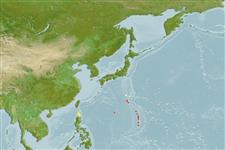Common names from other countries
Environment: milieu / climate zone / depth range / distribution range
Ecologia
marinhas associadas(os) a recifes; não migratória; intervalo de profundidade 1 - 56 m (Ref. 1602). Tropical; 28°N - 15°N
Western Pacific: known only from the Mariana and Ogasawara Islands; possibly a population southwest of Palau.
Tamanho / Peso / Idade
Maturity: Lm ? range ? - ? cm
Max length : 9.0 cm TL macho/indeterminado; (Ref. 9710); common length : 7.0 cm SL macho/indeterminado; (Ref. 37816)
Espinhos dorsais (total) : 14; Raios dorsais (total) : 16 - 18; Espinhos anais: 3; Raios anais : 17 - 18. Its ground color is variable, ranging from almost red to light apricot. The barring can be reduced to a small patch behind the operculum, and in rare cases, be entirely absent. The blue trim on the soft dorsal and anal fins is absent or reduced in females and highly developed in males.
A common species (Ref. 9710) found singly or in small groups in exposed outer reef slopes and occasionally in clear lagoon reefs. Prefers areas of mixed dead and living corals with numerous shelter holes and passages (Ref. 1602). Feeds mainly on benthic algae. Forms harems of 3-7 individuals. Occasionally exported through the aquarium trade (Ref. 48391).
Ciclo de vida ou comportamento de acasalamento
Maturities | Reprodução | Spawnings | Egg(s) | Fecundities | Larvas
Allen, G.R., 1985. Butterfly and angelfishes of the world. Vol. 2. 3rd edit. in English. Mergus Publishers, Melle, Germany. (Ref. 4858)
Status na Lista Vermelha da UICN (Ref. 130435)
CITES (Ref. 128078)
Not Evaluated
Ameaça para os humanos
Harmless
Uso pelos humanos
Pescarias: espécies comerciais; Aquário: Espécies comerciais
Ferramentas
Relatórios especiais
Baixar XML
Fontes da internet
Estimates based on models
Índice de diversidade filogenética (Ref.
82804): PD
50 = 0.5000 [Uniqueness, from 0.5 = low to 2.0 = high].
Bayesian length-weight: a=0.03090 (0.01359 - 0.07026), b=2.89 (2.70 - 3.08), in cm Total Length, based on LWR estimates for this (Sub)family-body shape (Ref.
93245).
Nível Trófico (Ref.
69278): 2.0 ±0.00 se; based on food items.
Resiliência (Ref.
120179): Elevada, tempo mínimo de duplicação da população menor que 15 meses (Preliminary K or Fecundity.).
Fishing Vulnerability (Ref.
59153): Low vulnerability (10 of 100).
